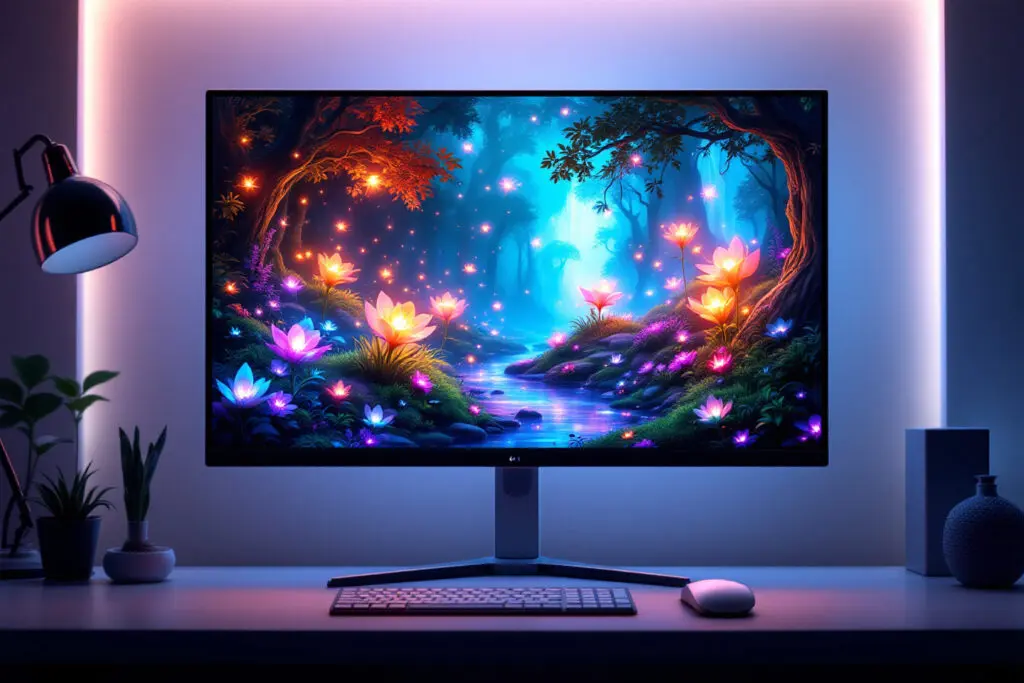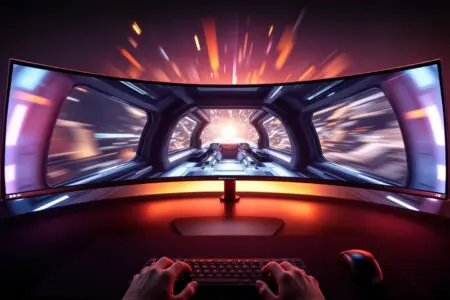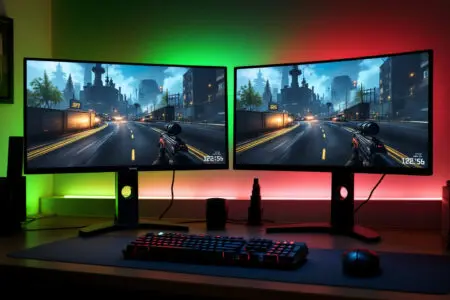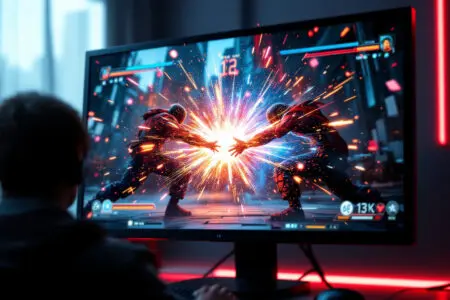So, you did it. You built the beast. The graphics card is purring, your CPU is staying frosty, and the RGB lighting is putting on a tiny rave inside your case. But now you’re at the final boss of PC building: choosing the monitor. You open a browser, ready to find your window to other worlds, and BAM. You’re hit with a barrage of alphabet soup. IPS. VA. TN. What on earth is the difference? It’s enough to make anyone’s eyes glaze over, but believe me, picking the right one is one of the most critical decisions you’ll make for your entire gaming setup.
This isn’t about boring specs on a box. This is the core technology that paints your entire visual world. It dictates whether a fantasy forest feels lush and alive or if you can clearly track an enemy zipping across your screen in a chaotic firefight. It’s everything. So, what is the best monitor panel type for gaming? There’s no single “right” answer, but I promise that by the time you’re done here, you’ll know exactly which one is right for you.
More in Monitors Category
Is a Curved Monitor Good for Gaming
Key Takeaways
- TN (Twisted Nematic): These are all about speed. Raw, unfiltered speed. They boast the quickest response times and highest refresh rates, making them the old-school favorite for hyper-competitive esports. That speed, however, comes at the steep price of washed-out colors and awful viewing angles.
- VA (Vertical Alignment): VA panels are the undisputed kings of contrast. They produce deep, inky blacks that make games and movies feel incredibly immersive. Their biggest potential flaw is a slower response time, which can sometimes create that dreaded motion blur or “ghosting” effect.
- IPS (In-Plane Switching): This is the crowd favorite for a reason. IPS panels deliver stunning, accurate colors and great viewing angles. For years, they were too slow for serious gaming, but modern “Fast IPS” panels are now so quick they rival TNs, making them a phenomenal all-around choice for almost any gamer.
- Your Games Dictate Your Choice: The “best” panel is a personal decision. A Valorant pro’s needs are worlds apart from someone exploring the gorgeous landscapes of Baldur’s Gate 3. Let your game library be your guide.
First Things First, What Exactly Is a Monitor Panel?
Before we get into the nitty-gritty, let’s clarify what a “panel” even is. The simplest way to think about it is as the high-tech canvas where your games are painted. It’s a multi-layered slice of technology, but the magic happens in a thin layer of liquid crystals.
When you send power to them, these tiny crystals twist and align themselves in incredibly precise patterns. How they’re aligned dictates how much light from the backlight shines through to form a single pixel. The secret sauce—the thing that separates a TN from a VA from an IPS—is all in how those tiny crystals dance. That single difference is the source of every strength and weakness we’re about to cover.
Remember the Old Guard? Let’s Talk About TN Panels.
For the longest time, if you were a “serious gamer,” you were using a TN, or Twisted Nematic, panel. Full stop. They were the undisputed champions of speed, the pioneers who kicked off the high-refresh-rate arms race that now defines PC gaming. They built an entire reputation on one thing: giving players a raw, competitive edge where a millisecond is the difference between winning and losing. For years, nothing else came close.
Why Were TN Panels the Go-To for So Long?
Speed. Blistering, uncompromising speed. TN panels were the first to smash past the old 60Hz barrier, giving us 120Hz, 144Hz, and eventually the bonkers 360Hz+ refresh rates we see today. Couple that with insanely fast pixel response times—often a true 1ms from one shade of grey to another—and you had a recipe for unparalleled motion clarity.
In a twitch shooter like CS:GO or Valorant, that’s a real, tangible advantage. It means you can track an opponent moving at full sprint without a blurry trail, letting you land shots with more precision. For the pros, these weren’t just nice features; they were requirements. The poor image quality was just the cost of doing business.
So, What’s the Catch with TN Technology?
The trade-off for that world-class speed is pretty much everything else. The most glaring issue with TN panels is their notoriously poor color reproduction. Games just look… sad. Colors are often muted and washed-out, robbing vibrant worlds of their life.
Then you have the viewing angles. They are, to put it mildly, atrocious. If you aren’t sitting directly in front of the screen, in the perfect sweet spot, the colors begin to warp dramatically. Even just shifting in your seat can make the image look like a poorly developed photograph. It’s distracting and completely immersion-shattering.
I played Overwatch at a pretty high level on a 144Hz TN panel and swore by its responsiveness. I was one of those guys who preached that a high frame rate was all that mattered and that “pretty colors” were for cinematic scrubs. Then I visited a friend who had just picked up a new IPS monitor. He fired up Red Dead Redemption 2. As he rode his horse into the sunset, my jaw just dropped.
The sky wasn’t just a flat orange; it was a living gradient of crimson, gold, and deep violet. The world felt real. I went home, looked at my own monitor, and suddenly all I could see was a dull, lifeless, brownish-grey world. I realized right then just how much beauty I had been missing.
Are VA Panels the King of Contrast?
Sitting comfortably between the speed-demon TN and the color-champion IPS is the VA, or Vertical Alignment, panel. VA technology attempts to be the best of both worlds, but its true claim to fame is one thing neither of the others can touch: a phenomenal contrast ratio. If you want your darks to be truly, deeply black, this is where you look.
What Makes Those Blacks So Deep on a VA Monitor?
It’s all in the name. When a pixel on a VA panel needs to be black, its liquid crystals align vertically, forming a near-perfect barrier against the monitor’s backlight. IPS and TN crystals just can’t block light as effectively. This creates a contrast ratio you can see, often measured at 3000:1 or higher, meaning the brightest white is 3,000 times brighter than the darkest black. Most IPS and TN panels are stuck around 1000:1.
In a game, this means a dark dungeon in Elden Ring actually looks like a dark, foreboding dungeon, not a hazy, glowing grey mess. It adds a palpable sense of depth and realism, which is why these panels are a dream for horror games and cinematic epics.
Have You Ever Heard of “VA Ghosting”?
This is the skeleton in the VA closet. While the technology has improved by leaps and bounds, many VA panels—especially on the cheaper end—can suffer from slower pixel response times. This is most obvious in transitions from pure black to other colors, creating a nasty effect called ghosting or black smearing.
I learned this the hard way. A few years back, I snagged a great deal on a VA monitor, excited for those deep blacks in games like DOOM Eternal. In bright areas, it was glorious. But the second I stepped into a dark corridor, my heart sank. As I whipped my aim around, I could see a faint, blurry trail smearing behind enemies and objects against dark backgrounds. It was so distracting it completely ruined the flow of the game’s lightning-fast combat. That monitor taught me an important lesson: amazing contrast doesn’t mean a thing if the pixels can’t keep up.
Why Does Everyone Seem to Love IPS Panels Now?
For what felt like an eternity, IPS (In-Plane Switching) panels were reserved for the artsy crowd—graphic designers, photographers, and video editors. They were prized for their incredible color accuracy and wide, stable viewing angles. But their slow performance and high price tags made them a non-starter for gamers.
Well, the game has completely changed.
In recent years, breakthroughs have utterly transformed IPS technology. Manufacturers figured out how to make them fast—really fast. These “Fast IPS” panels have all but eliminated the response time gap with TNs. At the same time, prices have plummeted. What we’re left with is a panel that delivers both breathtaking colors and elite gaming performance. It’s a combination that has rightfully made IPS the new default choice for most PC gamers.
What’s the Secret Behind Those Gorgeous IPS Colors?
The magic is in the crystal alignment. Instead of standing up vertically (like VA) or twisting (like TN), the crystals in an IPS panel rotate horizontally—”in the same plane.” This horizontal movement gives them much finer control over the light passing through, allowing them to reproduce a wider and more accurate palette of colors.
This is why you see IPS monitors advertised with specs like “98% DCI-P3 coverage.” It means they can show you more of the colors the game developers actually intended. The difference is night and day. The jungles in Horizon Zero Dawn explode with vibrant greens, and the neon glow of Cyberpunk 2077‘s Night City feels electric. Plus, those fantastic viewing angles mean the picture stays perfect even when you’re leaning back or have a friend watching over your shoulder.
But Aren’t IPS Panels Slower and More Expensive?
That’s an outdated stereotype. As I mentioned, modern “Fast IPS” panels regularly clock in with true 1ms grey-to-grey (GtG) response times. This puts them neck-and-neck with the fastest TNs, making the old “speed vs. beauty” argument a thing of the past for all but the absolute top tier of esports pros who demand every last microsecond.
And while the very best IPS monitors carry a hefty price tag, the technology is now available at every price point. The small amount extra you might pay for an IPS over a comparable VA or TN is, for most people, an investment that pays off every single time you boot up a game.
What is This “IPS Glow” I Keep Hearing About?
Nothing is perfect. The one area where IPS panels still lag behind is native contrast. Because their crystals don’t block backlight as perfectly as VA panels, their blacks can look more like a dark charcoal grey, especially in a completely dark room.
This can also appear as “IPS glow,” a faint glow, often whitish, that you might see in the corners of the screen on a very dark image. It’s an inherent trait of the technology, and its intensity varies from one monitor to the next. For most people, it’s a total non-issue you’ll never notice in the heat of a game. But for those who crave the deepest possible blacks, it’s the one clear advantage VA still holds.
So How Do I Choose the Right Panel for My Favorite Games?
Okay, we’ve broken down the tech. Now let’s connect it to what really matters: your games. The best way to choose is to be honest about what you play most often. Different genres have different needs, and matching your monitor’s strengths to those needs is the path to gaming bliss.
Are You a Competitive Esports Legend?
- Your Games: Valorant, CS:GO, Apex Legends, Overwatch, League of Legends
- Your Priority: Maximum refresh rate and the absolute fastest response time for the clearest possible image in motion.
- The Verdict: This is the one niche where a top-of-the-line TN panel could still be considered, but only if you’re a pro or an aspiring pro who absolutely needs a 360Hz+ refresh rate. For the other 99.9% of competitive players, a modern Fast IPS is the smarter buy. It’s so close in speed you’ll never notice the difference, but the vastly superior colors can actually make it easier to spot enemies and track abilities.
Do You Live for Cinematic, Immersive Worlds?
- Your Games: The Witcher 3, Cyberpunk 2077, Elden Ring, Alan Wake 2, Starfield
- Your Priority: Breathtaking visuals, rich and accurate colors, and a deep sense of atmosphere.
- The Verdict: This is a showdown between IPS and VA. An IPS will paint these gorgeous worlds with spectacular, true-to-life color, making every scene a masterpiece. A high-quality VA, however, will provide a sense of depth and atmosphere that is second to none, thanks to its inky blacks—a massive bonus for horror or space games. If you play in a dark room and crave that cinematic feeling, a good VA is a stellar choice. Otherwise, IPS is the safer, more vibrant option.
Are You a Jack-of-All-Trades Gamer?
- Your Games: A little bit of everything! A few rounds of Call of Duty, some questing in World of Warcraft, and the latest indie darling.
- Your Priority: Versatility. You need a monitor that can keep up with fast action but still do justice to a beautiful, story-rich adventure.
- The Verdict: Easy. This is IPS territory, all the way. It no longer has a real-world speed disadvantage for most gamers, and its phenomenal color performance and viewing angles make it a pleasure to use for absolutely everything—gaming, watching movies, browsing the web, you name it. It is the ultimate do-it-all panel.
What About the Technical Specs? Does the Panel Type Dictate Everything?
Picking a panel type gets you most of the way there, but you still need to look at the specs of the individual monitor. The panel is the foundation, but the features built around it matter just as much.
How Do Response Time and Refresh Rate Factor In?
Refresh rate (in Hz) is how many times your screen redraws the image per second. Response time (in ms) is how fast a pixel can change its color. For a fluid gaming experience, you want a high refresh rate (144Hz is a great baseline) and a low response time (ideally under 4ms GtG).
While the panel type gives you a ballpark idea of performance, specific models can vary a ton. Manufacturers use tricks like “overdrive” to speed up pixels. That’s why you can’t just assume an IPS is slow. Always, always check professional reviews from trusted sources. Outlets like RTINGS.com do deep-dive testing that shows the true performance, which is often very different from the “1ms” number slapped on the box.
Does HDR Look Better on a Certain Panel?
Good High Dynamic Range (HDR) needs two things: searingly high brightness and incredible contrast. You need to be able to show brilliant highlights right next to deep shadows.
Thanks to their massive native contrast, VA panels have a natural advantage here. A VA monitor with a DisplayHDR 600 rating will often look more impressive than an IPS with the same rating, simply because its deep blacks make the bright spots pop more. However, this is all being upended by Mini-LED backlight technology. Mini-LED gives monitors thousands of local dimming zones, massively boosting the contrast of both IPS and VA panels and enabling a truly spectacular HDR experience.
Ultimately, the quest for the perfect monitor is about knowing yourself. The endless IPS vs. VA vs. TN war isn’t about crowning one champion; it’s about understanding what each one brings to the table and matching it to your own priorities. Are you chasing leaderboard glory? A Fast IPS is your weapon. Do you want to feel a chill run down your spine in a horror game? A great VA will deliver. Or do you simply want a vibrant, beautiful canvas for every adventure that comes your way? An IPS is calling your name. The best monitor is the one that makes you forget it’s even there, pulling you completely into the game.
FAQ – What is the Best Monitor Panel
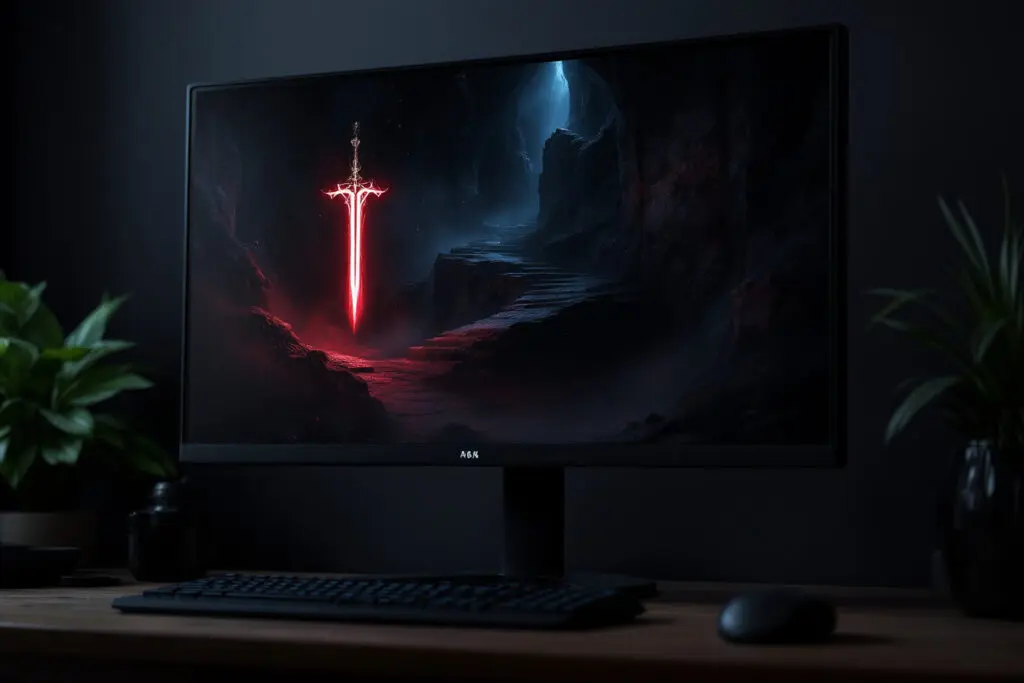
Is it worth investing in an IPS monitor despite potential drawbacks like IPS glow and price?
Yes, modern IPS monitors have fast response times comparable to TN panels and offer breathtaking colors and wide viewing angles, making them ideal for most gamers. Although some may experience IPS glow in dark scenes, its impact is minimal for many users, and the overall benefits of superior image quality and versatility often outweigh these minor disadvantages.
What should I consider when selecting a monitor panel based on my gaming genre or style?
Choose a TN panel if you prioritize ultra-fast responsiveness for competitive esports. Opt for IPS if you want vibrant colors and sharp images for immersive or story-rich games. Select VA if deep blacks and high contrast improve your experience in dark atmospheres or horror games. For versatile gaming across genres, modern IPS panels offer a balanced performance.
How does the choice of monitor panel affect HDR quality and gaming experience?
VA panels typically provide better HDR experiences because they have higher contrast ratios, making highlights and shadows more vivid. Models with Mini-LED backlighting and local dimming further enhance HDR by improving contrast and brightness, regardless of panel type. The right panel depends on your preference for deep blacks versus vibrant colors or cinematic immersion.

